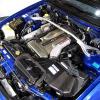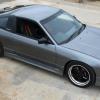tyre pressure for the track
Announcements
-
Similar Content
-
Latest Posts
-
I’m thinking that’s the route I’ll go, thanks for the input!
-
Hey all, my 2004 Nissan Skyline 350GT overheated the other day with coolant boiling and leaking out of the coolant reservoir when I was parking. So today, I started it up again just to see if it was a thermostat/head gasket issue. After about 20 mins of running, temps were normal again, no coolant was leaking out and the upper reservoir hose was warm but my engine suddenly cut off. I checked the oil dipstick and cap when it was running and there was no white foamy residue and the exhaust did not have white smoke. I tried starting up the car again but it would only crank, similar to when I had a camshaft sensor issue just that now there’s no check engine light on the dash. Any ideas? Unfortunately I don’t have an OBD2 that can read the Nissan's programme.
-
By Papichulo96 · Posted
Bump on this to not make another post, had a ‘head drain’ leak on me and have the engine out as we speak. Planning on just putting a new freeze plug back in , plug the tapped holes and just be done with that headache. Now I still want to relieve pressure to allow oil to pass down the blocks returns easier. I’ve seen catch cans with multiple vents help folks with this issue on this forum. I’m wanting to make my own. I have some pictures here of my setup if anyone can help how I should plumb and design the catch can I would deeply appreciate it ! rb25 Oil upgrades: 1.0mm restrictor n1 pump/billet gears extended crank collar extended sump with trap doors/w welded fitting -
The Frenchy's kit is the way to go forward. A modern compressor that weighs about 1/2 as much, is at least twice as efficient, and will do a good job on R134a. And of course the kit has everything else you need to connect it up and have it work properly.
-
Hey all , I am in the process of having the AC system in my r32 GTST converted from r12 to r134a and I’m being told my compressor has gone bad and I will need a new one. I was wondering if anybody has any suggestions for what is the best route to go aside from dropping $1500 on a new oem one? I did see that Frenchy’s performance garage offers a kit to mount a Toyota compressor, has anybody actually used this kit on their car? Or is there anywhere I could purchase just a clutch? Any help is appreciated.
-







Recommended Posts
Create an account or sign in to comment
You need to be a member in order to leave a comment
Create an account
Sign up for a new account in our community. It's easy!
Register a new accountSign in
Already have an account? Sign in here.
Sign In Now